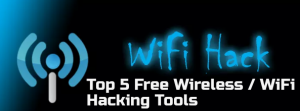
Hello Friends Today We’ll discuss about Top 5 All Time Popular
Wireless / WiFi Hacking Tools. You can use these popular wireless
hacking packages and do penetration testing on your own wifi network
whether your network is secure or hackable. I strongly recommend you to
use Kali Linux OS because this OS has built-in software’s such as
Aircrack-ng (set of tools for auditing wireless networks) which helps in
cracking WEP and WPA-PSK keys.
To crack a network you also need to have the right kind of Wi-Fi adapter
in your computer, one that supports packet injection. You need to be
comfortable with the command line (running things using CMD/Terminal)
and have a lot of patience. Your Wi-Fi adapter and Aircrack have to
gather a lot of data to get anywhere close to de-crypting the passkey on
the network you are targeting.
Top 5 All Time Popular Wireless / WiFi Hacking Tools – 2017/2018
Following is the list of Top 5 All Time Popular Wireless / WiFi Hacking Tools you can use for penetration testing and make your network more secure.
1. Aircrack-ng
Aircrack-ng is a complete suite of tools to assess WiFi network security.
It focuses on different areas of WiFi security:
- Monitoring: Packet capture and export of data to text files for further processing by third party tools.
- Attacking: Replay attacks, deauthentication, fake access points and others via packet injection.
- Testing: Checking WiFi cards and driver capabilities (capture and injection).
- Cracking: WEP and WPA PSK (WPA 1 and 2).
All tools are command line which allows for heavy scripting. A lot of
GUIs have taken advantage of this feature. It works primarily Linux but
also Windows, OS X, FreeBSD, OpenBSD, NetBSD, as well as Solaris and
even eComStation.
2. Wireshark
Wireshark is the world’s foremost and widely-used network protocol
analyzer. It lets you see what’s happening on your network at a
microscopic level and is the de facto (and often de jure) standard
across many commercial and non-profit enterprises, government agencies,
and educational institutions. Wireshark development thrives thanks to
the volunteer contributions of networking experts around the globe and
is the continuation of a project started by Gerald Combs in 1998.
Features:
- Deep inspection of hundreds of protocols, with more being added all the time
- Live capture and offline analysis
- Standard three-pane packet browser
- Multi-platform: Runs on Windows, Linux, macOS, Solaris, FreeBSD, NetBSD, and many others
- Captured network data can be browsed via a GUI, or via the TTY-mode TShark utility
- The most powerful display filters in the industry
- Rich VoIP analysis
- Read/write many different capture file formats: tcpdump (libpcap), Pcap NG, Catapult DCT2000, Cisco Secure IDS iplog, Microsoft Network Monitor, Network General Sniffer® (compressed and uncompressed), Sniffer® Pro, and NetXray®, Network Instruments Observer, NetScreen snoop, Novell LANalyzer, RADCOM WAN/LAN Analyzer, Shomiti/Finisar Surveyor, Tektronix K12xx, Visual Networks Visual UpTime, WildPackets EtherPeek/TokenPeek/AiroPeek, and many others
- Capture files compressed with gzip can be decompressed on the fly
- Live data can be read from Ethernet, IEEE 802.11, PPP/HDLC, ATM, Bluetooth, USB, Token Ring, Frame Relay, FDDI, and others (depending on your platform)
- Decryption support for many protocols, including IPsec, ISAKMP, Kerberos, SNMPv3, SSL/TLS, WEP, and WPA/WPA2
- Coloring rules can be applied to the packet list for quick, intuitive analysis
- Output can be exported to XML, PostScript®, CSV, or plain text
3. Kismet Wireless
Kismet is a wireless network detector, sniffer, and intrusion
detection system. Kismet works predominately with Wi-Fi (IEEE 802.11)
networks, but can be expanded via plug-ins to handle other network
types.
Features
- 802.11 sniffing
- Standard PCAP logging (compatible with Wireshark, TCPDump, etc)
- Client/Server modular architecture
- Plug-in architecture to expand core features
- Multiple capture source support
- Live export of packets to other tools via tun/tap virtual interfaces
- Distributed remote sniffing via light-weight remote capture
4. AirSnort
AirSnort is a wireless LAN (WLAN) tool which cracks encryption keys on 802.11b WEP networks. AirSnort operates by passively monitoring transmissions, computing the encryption key when enough packets have been gathered.
5. Pixiewps
Pixiewps is a tool written in C used to bruteforce offline the WPS
PIN exploiting the low or non-existing entropy of some Access Points,
the so-called “pixie-dust attack” discovered by Dominique Bongard in
summer 2014. It is meant for educational purposes only.
As opposed to the traditional online brute-force attack, implemented in
tools like Reaver or Bully which aim to recover the pin in a few hours,
this method can get the PIN in only a matter of milliseconds to minutes,
depending on the target, if vulnerable.
